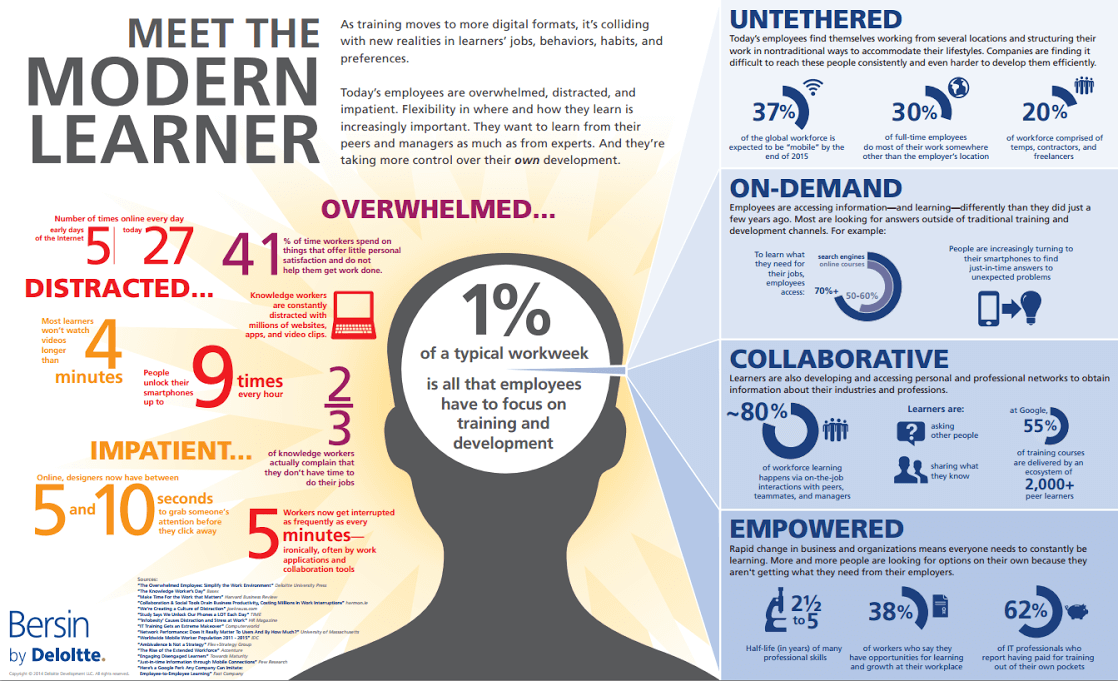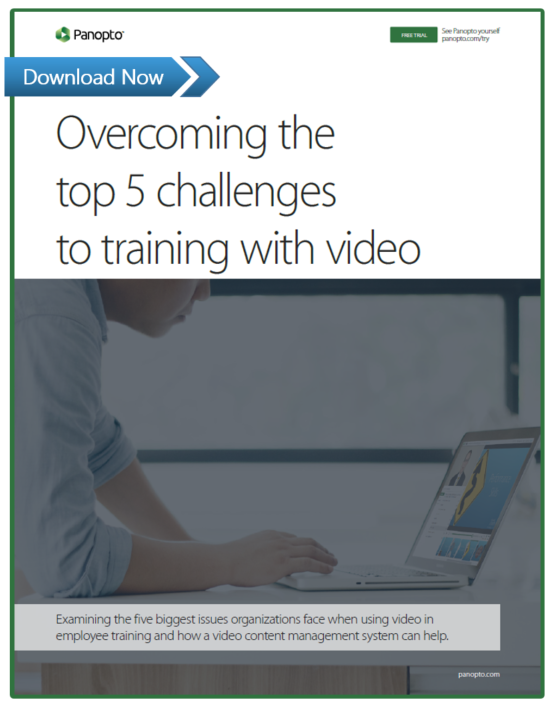- Social Learning & Knowledge Management
When There Isn’t Time For Learning, You Learn “In The Flow Of Work”
Something big happened in 1998: Google was born. Within just a few short years, internet users went from browsing the web — clicking from one page to the next via links — to actually searching the web. Twenty years later, search remains our go-to strategy for finding out more about virtually everything, from new restaurants nearby to ancient public records.
Then in 2002, another something big: Friendster and LinkedIn both launched, followed in 2003 by MySpace and 2004 by Facebook. In short order, social sites would change not just how we share information and communicate, but also the rate at which new ideas can spread.
Still another something big came about in 2005, when YouTube added streaming online video to the mix and gave us all yet another way to share and acquire information.
And though there had been a number of predecessors, 2007 saw Apple’s launch of the iPhone and the resulting near-instant adoption of the smartphone that put everything in the palms of our hands, 24-hours a day, 7-days a week.
Global Digital Trends at Work
These global digital trends have redefined the way we shop, commute, communicate, and learn. And not only have they changed the way we live, they’ve changed the way we work.
Just as with the new apps that help us become more efficient in our personal lives, technologies that make us more productive and informed at work are rapidly reshaping corporate technology ecosystems. And just as with our personal technologies, today’s changes stem not from top-down executive-driven digital transformations, but employee demand at the grassroots level.
In her highly anticipated 2018 Internet Trends Report — the annual “State of The Union” for the tech industry — Mary Meeker and her team of analysts at Kleiner Perkins Caufield & Byers note two major trends in enterprise technology that illustrate this:
- Easy to use consumer-grade apps like Slack, Zoom, and Dropbox have grown rapidly by improving communication and the flow of information at work, appealing directly to the time-strapped end user.
- These extensible, worker-driven productivity apps integrate easily into other business systems, better organizing information, connecting teams, providing context, and showing historical data.
At work, we want immediate answers when we need them. Google taught us we could have this back in 1998, and in the years hence, Facebook, YouTube, and Apple only reinforced the lesson.
Finding Time For Learning
Josh Bersin, Principal & Founder, Bersin / Deloitte Consulting and a a leading analyst in the corporate learning space, has been tracking this same trend. His interest, however, isn’t in technology for its own sake; rather, as an evolving facilitator of a macro learning trend he refers to as “learning in the flow of work.”
A recent LinkedIn Learning survey of over 4.000 professionals revealed that the number one challenge for talent development is convincing employees to find more time for learning. Bersin’s research confirms that employees dedicate only 1 percent of a typical work week to focus on training and development — just 24 minutes a week.

As a result, more and more learning is happening in the moment, or “in the flow.”
This partly explains the success of productivity tools like Slack, Zoom, Dropbox, and even Panopto. These apps make it possible for workers to tap into institutional knowledge whenever they need to.
Whether it comes directly from a co-worker on Slack or Panopto, or from documentation stored in Dropbox or Google Drive, the bottom line is that most employees will go to wherever they believe they’ll be able to get the fastest access to the information they need. But how do we make sure they find what they need when they get there?
Supporting Learning In the Flow of Work
In today’s organizations, the role of learning and development (L&D) teams has expanded to encompass not only formal employee training, but to supporting a variety of forms of informal social learning and knowledge exchange as well.
Today’s L&D professional is both creator and curator, supporting the programs and systems that make serendipitous learning moments possible. This includes not only creating flexible on-demand formal training content, but also ensuring institutional knowledge from experts within the organization is archived and retained.
And that means when it comes to supporting learning in the flow of work, L&D practitioners must focus not only on the “learning” aspect, but on the “in the flow of work” element as well.
By way of example, let’s consider your sales team.
In all likelihood, every member of the team lives in Salesforce. So If you’re building a system that enables learning on-demand for your sales team, it needs to plug into Salesforce to make training topics easily discoverable.
Here’s how this might work: Imagine you’ve recorded a series of soft-skills training modules intended to coach your reps on their customer interactions. You also encourage sales reps to record quick knowledge dumps on their smartphones that might help other reps close deals, and you curate the best of those to share with the team.
Of course, just creating the content is step 1. You have to put it somewhere others can access it. So for your sales team, you’re hosting the videos in your corporate YouTube, which integrates with Salesforce to make video-based knowledge searchable (every word spoken and every word shown on screen) right within your Salesforce CRM. The rest of your knowledge base — PowerPoints, PDFs, and other text-based documentation — is organized in Dropbox, which also integrates with Salesforce to become searchable in that system.
Now comes the test.
One of your sales reps is working an account that should be a quick win, but a competitor is pitching too and your rep is having trouble getting the sale to close. Because your video knowledge-base is integrated with Salesforce, when that rep types in a search for “overcoming objections,” your video training module on the topic appears and she watches it. She then searches Salesforce for the competitor’s name, which returns a point-by-point teardown of your product versus the competitor that the marketing team uploaded to Dropbox. She also finds a few videos uploaded to your corporate YouTube from other reps that talk about deals they closed when they were up against that same competitor.
Without ever leaving the familiar environment of Salesforce, your salesperson can study the teardown, watch videos from the other reps, and prepare herself to go into the next client meeting ready to move the deal forward.
Today’s top learning organizations have already begun to architect digital ecosystems that enable learning in the flow of work, just like in the example scenario above. The applications that make up these ecosystems not only integrate seamlessly with each other but also support the discovery of knowledge and quick learning from anywhere.
As Bersin’s noted, “These applications all build on the 20 years of infrastructure we’ve built (search, video, mobile, recommendations, and fast internet access) and add the principles of spaced learning, designed repetition, practice, and competency-driven recommendations right into an employee’s work environment.”
The strategy and execution will be different for every organization, of course, but the goal is the same: embed flexible learning content into the platform(s) in which your people work the most to maximize the training they get as they are working. All together, that will mean that no matter what problems these apps solve for workers in your organization, they’ll also help you build an infrastructure that supports on-demand, searchable, mobile-ready, video-based learning that can be accessed from the tools they already use most.

Support Learning In The Flow Of Work With Video
It’s no longer a secret that supporting rapid video-based learning is a top priority for many of the world’s best learning organizations. But as businesses record more and more video, they often realize that the systems they are using to manage and share videos are broken.
Learn about the top five challenges that often impede organizations from maximizing learning through video and how a video content management system (video CMS) can solve all of them in our latest white paper.
DOWNLOAD: Solving the Top 5 Challenges to Training with Video


